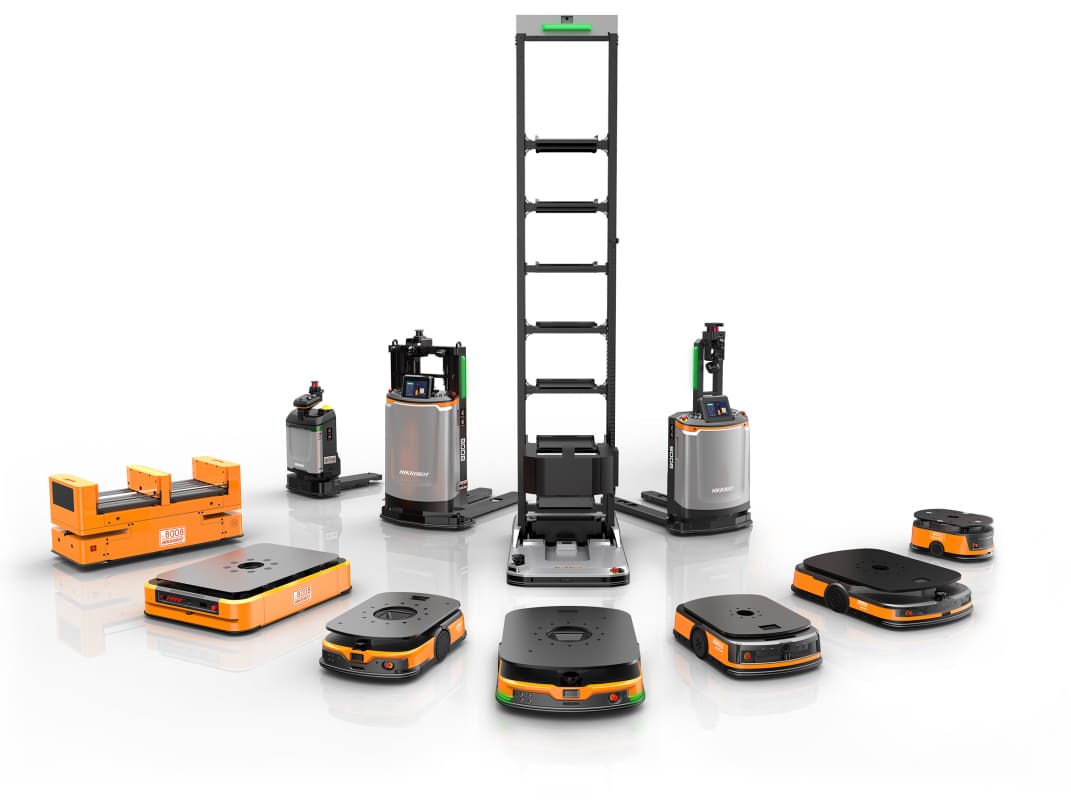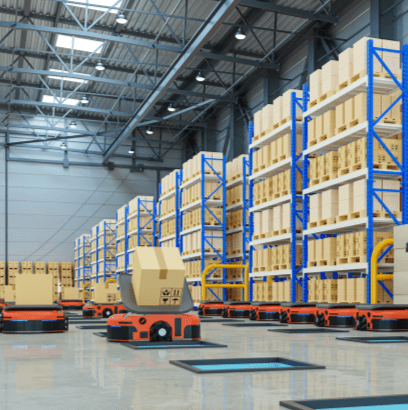
What is an AGV vehicle
When asking What is automated guided vehicle system, it refers to an autonomous transportation system designed to move goods and equipment within indoor facilities without human intervention. AGVs have become increasingly popular in warehouses, where they navigate complex layouts to handle large volumes of incoming and outgoing products. In environments with diverse inventory, managing storage locations and tracking transport status manually can lead to delays and errors. By automating these processes, AGVs significantly improve operational efficiency and accuracy, making them an essential solution for modern warehouse and logistics operations.

AGV vehicle technology significantly enhances transportation efficiency in warehouses. Compared to manual labor, AGVs offer precise, rapid, and continuous operation over extended working hours. This automation reduces errors and issues associated with human labor, improving overall reliability and productivity in material and goods handling within the warehouse.
With its ability to transport and move goods, AGV technology also enhances operational efficiency on production lines in industrial factories. Implementing automation for warehouse management or goods transportation in industrial settings is a strategic choice to adapt to future changes. AGVs effectively meet these needs by providing reliable and efficient solutions for handling materials and products.
How do AGV Vehicle Work
Automated Guided Vehicles (AGVs) operate based on a combination of sensors, software, and control systems that allow them to navigate and transport materials without direct human control. To explain the working principle of AGV, these vehicles use technologies such as laser guidance, magnetic tape, or vision-based navigation to determine their routes and avoid obstacles while efficiently moving goods within industrial environments.
Automated Guided Vehicle Working Principle
Navigation & Guidance:
AGVs follow predefined paths or maps using technologies such as magnetic strips, QR codes, laser scanners, or even advanced SLAM (Simultaneous Localization and Mapping). This ensures they move accurately within complex warehouse layouts.
Onboard Sensors & Safety:
Equipped with sensors like LiDAR, ultrasonic, and cameras, AGVs continuously detect obstacles and adjust their path in real time. This minimizes the risk of collisions and ensures safe operation around people and equipment.
Communication & Integration:
AGVs connect with warehouse management systems (WMS) or ERP systems to receive transport tasks and update their status. This seamless integration ensures the right goods are moved at the right time.
Load Handling Mechanisms:
Depending on the type, AGVs may have conveyors, forks, or robotic arms to pick up and deliver loads. This allows them to automate various types of material handling without manual intervention.
Components of Automated Guided Vehicle Systems
Vehicle Body & Drive System:
The AGV’s chassis, wheels, and motors determine speed, load capacity, and maneuverability, tailored to specific warehouse or factory tasks.
Navigation & Guidance System:
Uses magnetic tape, QR codes, lasers, or SLAM technology to help the AGV follow paths or adapt dynamically within complex environments.
Onboard Control & Computing Unit:
Acts as the brain, processing sensor data, managing navigation, speed, obstacle avoidance, and overall operational logic.
Sensors & Safety Devices:
Equipped with LiDAR, ultrasonic sensors, cameras, and emergency systems to detect obstacles and ensure safe operation around people and equipment.
Load Handling Equipment:
Includes conveyors, forks, or robotic arms that automate the pick-up, transport, and placement of goods without manual handling.
Communication System:
Connects the AGV with WMS, ERP, or fleet control software, enabling real-time task updates, tracking, and integration with warehouse operations.
Charging & Power Management:
Uses rechargeable batteries with automated docking or wireless charging, supported by smart power systems to maximize uptime and efficiency.
History and Evolution of AGV Vehicle
Below is a brief timeline showcasing the automated guided vehicle history,
illustrating how AGVs have progressed from simple wire-guided machines to today’s intelligent, fully autonomous systems.
1950s:
First AGVs introduced as tow tractors following fixed wires on factory floors.
1970s:
Magnetic tape and guide paths replace wires, allowing easier layout changes.
1980s:
Laser-guided systems emerge, enabling more flexible navigation in warehouses.
2000s:
Integration with warehouse management systems (WMS) becomes standard, improving task coordination.
2010s:
Adoption of vision systems, LiDAR, and advanced sensors for smarter obstacle detection.
2020s:
SLAM (Simultaneous Localization and Mapping) and AI-driven navigation make AGVs fully autonomous, adaptable to dynamic environments.
Automated Guided Vehicle Applications
AGVs are used across many industries to automate material handling and improve efficiency. Common applications include warehouses, manufacturing plants, and logistics centers where companies often look for an automated guided vehicle for sale to enhance productivity and reduce labor costs.
Warehouses:
Moving pallets, cartons, and products between storage areas and shipping docks.
Manufacturing:
Supplying parts to production lines, transferring semi-finished goods, and removing waste.
E-commerce & Distribution Centers:
Picking, sorting, and transporting orders to speed up fulfillment.
Food & Beverage:
Handling raw materials and finished goods in clean, controlled environments.
Automotive:
AGV in automotive industry Transporting heavy components like engines and chassis through assembly processes.
Hospitals & Healthcare:
Delivering medical supplies, linens, and meals to reduce staff workload.
TYPE OF AGV Vehicle WE USED
Benefits of Using an AGV Vehicle
- Quick Return on Investment: Generally, the payback period ranges from 10 to 24 months.
- Reduced Production Costs: Minimizes expenses related to labor for transporting raw materials or products in the production process.
- Space Efficiency: Saves space by reducing the area needed for storage of goods and raw materials awaiting production.
- Versatile Application: Can be adapted for various production processes, offering flexible usage.
- Safety: Operates without human drivers, reducing the risk of accidents caused by human error.
- Heavy Duty: Capable of handling loads up to 4 tons, making heavy tasks easier.
- Easy Route Adjustments: Allows for simple changes to the routing when production systems are updated, making route management straightforward.
- Increased Production Efficiency: Reduces wait times for materials and enhances time management, improving overall production quality.
- Personnel Issues Reduction: Minimizes problems related to human resources, such as absenteeism, tardiness, or emergency leave.
- Environmental Considerations: Uses electric-powered machinery to reduce air pollution, contributing to environmental sustainability.
- Advanced Technology: Features high-quality machinery and equipment imported from Japan.
- Local Installation and Assembly: Machinery and equipment are installed and assembled in Thailand, supporting local industry.
Projects Reference
We provide complete warehouse management solutions tailored to every business's needs.
FAQs About AGV Vehicle
AGV or Automated Guided Vehicle technology is an autonomous transport robot that uses sensors and navigation systems such as laser or cameras to transport materials to destinations without a driver.
AGV is suitable for industries that require automated transport systems to reduce labor and increase efficiency, such as:
- Logistics and Warehousing – Using AGV in distribution centers for package transportation
- Manufacturing – Assisting in transporting components and raw materials within factories
- Automotive – Using AGV in automobile assembly lines
- Food & Beverage (F&B) – Helping transport raw materials and products to packaging points
- Electronics – Delivering components and products that require high precision
The price of AGV Vehicle depends on the type of AGV, technology used, and project scale. Generally, prices range from hundreds of thousands to several million baht, depending on system complexity. Request a free quotation and consultation from AEI Solution.
AEI Solution’s customers include industrial manufacturing businesses, warehouses, logistics centers, and production facilities that want to increase internal transportation efficiency with AGV systems. By understanding the benefits of implementing AGVs in warehouses, these businesses can optimize workflow, reduce manual labor, and enhance overall productivity.
- AGV uses predetermined paths such as magnetic strips
- AMR (Autonomous Mobile Robot) uses cameras and laser navigation with autonomous navigation capabilities and can avoid obstacles independently
AEI Solution provides design, installation, and maintenance services for AGV covering throughout Thailand and Southeast Asia region, such as:
- Bangkok and surrounding areas
- Chonburi, Rayong (Eastern Seaboard – heavy industry and manufacturing plants)
- Ayutthaya, Nakhon Ratchasima (automotive industry and logistics)
- Other regions according to customer requirements
Installation time depends on project size and system complexity. Generally, it may take from 2 weeks to several months.
Yes! AEI Solution’s AGV can integrate with ERP (Enterprise Resource Planning) and WMS (Warehouse Management System) to enhance management efficiency.
AGV requires periodic maintenance such as:
- Checking batteries and sensors
- Updating software to stay current
- Inspecting navigation systems to ensure accurate operation
AEI Solution has experience in industrial automation systems, providing comprehensive services from consultation, design, installation, and after-sales support to ensure your business operates at maximum efficiency







